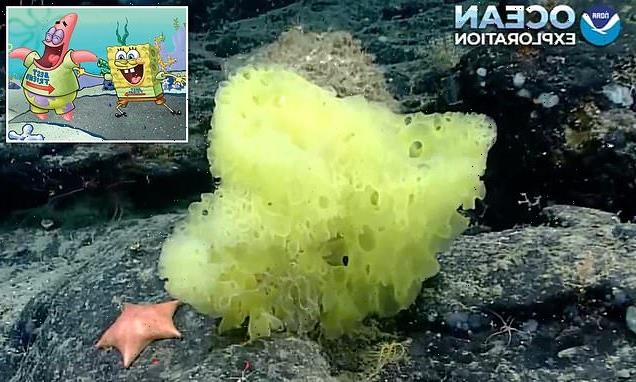
The ‘real life’ SpongeBob SquarePants and Patrick Star! Marine scientists spot a yellow sponge and pink sea star deep under the Atlantic waves that look just like the cartoon characters
- Marine scientists have spotted a yellow sea sponge and pink sea star in real life
- They were found on an underwater mountain 200 miles east of New York City
- Several impressed Twitter users responded to the photo, with one joking that the pair had ‘frozen’ just before the camera appeared
Since it first aired back in 1999, SpongeBob SquarePants has been one of the most popular cartoons around the world.
The Nickelodeon series follows the main character, a yellow sea sponge named SpongeBob and his best friend, a pink sea star named Patrick Star on their adventures around Bikini Bottom.
Now, marine scientists have spotted a yellow sea sponge and pink sea star in real life.
The adorable duo were spotted on the side of an underwater mountain called Retriever seamount, around 200 miles east of New York City.
Christopher Mah, a scientist with the National Oceanic and Atmospheric Administration (NOAA), shared his findings on Twitter, joking: ‘I normally avoid these refs… but WOW. REAL LIFE SpongeBob and Patrick!’
Marine scientists have spotted a yellow sea sponge and pink sea star in ‘real life’. The adorable duo were spotted on the side of an underwater mountain called Retriever seamount, around 200 miles east of New York City
The animals were spotted by a remotely operated vehicle (ROVs), sent from the NOAA’s Okeanos Explorer ship.
Mr Mah explained that they are a Hertwigia (sponge) and Chondraster (starfish).
Speaking to Insider, he added: ‘I thought it would be funny to make the comparison, which for once was actually kind of comparable to the iconic images/colors of the cartoon characters.
The Nickelodeon series follows the main character, a yellow sea sponge named SpongeBob and his best friend, a pink sea star named Patrick Star on their adventures around Bikini Bottom
‘As a biologist who specializes in sea stars, most depictions of Patrick and Spongebob are incorrect.’
Several impressed Twitter users responded to the photo, with one joking that the pair had ‘frozen’ just before the camera appeared.
They wrote: ‘You just know they were cutting it up right before the camera came… they were like FREEZE.’
Another added: ‘The Netflix adaptation looks great!’
The Okeanos mission has been in progress since 2009, with the aim of understanding more about waters and the seafloor off the coast of the US.
NOAA explained: ‘The baseline data collected during these missions is helping to close significant gaps in our basic understanding of US deep waters and seafloor and the resources they hold, providing information that is critical to sustaining the economy, health, and security of our nation.’
This isn’t the first time that a ‘real life’ Patrick Star has been spotted in the flesh.
In 2019, a photo of a Patrick Star-like starfish went viral on Twitter for a rather ‘cheeky’ reason.
In the image, the starfish looks like it has a rather peachy bottom, or ‘thicc a**’, as its photographer describes it.
The photo was posted to Twitter by Akari at the end of last month, after she spotted the hilarious animal at California’s Aquarium of the Pacific.
While the starfish looks like it has a human-like bum, sadly this isn’t actually the case.
Speaking to USA Today, Nate Jaros, curator of fish and invertebrates at the Aquarium of the Pacific, explained: ‘Sea stars are actually invertebrates or animals without backbones and not fish despite people commonly referring to them as ‘starfish.’
‘In this photo, the sea star is on a vertical rock face with two of its arms holding the rock and two arms hanging in a relaxed position. Sea stars sometimes relax their arms such as when they are eating.
‘Since the sea star is oriented vertically, gravity is causing its internal components to slump.’
Starfish or sea star?
Scientists recently made the decision to change the name ‘starfish’ to ‘sea star’ because they’re not actually fish.
NOAA explained: ‘Sea stars live underwater, but that is where their resemblance to fish ends. They do not have gills, scales, or fins. Sea stars live only in saltwater. Sea water, instead of blood, is actually used to pump nutrients through their bodies via a “water vascular system.”
‘Also, sea stars move by using tiny tube feet located on the underside of their bodies. Adult sunflower sea stars can move at the astonishing speed of one meter per minute using 15,000 tube feet. Tube feet also help sea stars hold their prey.
‘Sea stars are related to sand dollars, sea urchins, and sea cucumbers, all of which are echinoderms, meaning that they have five-point radial symmetry.
‘However, this does not mean that all sea stars have five arms and species with 10, 20, or even 40 arms exist! If one of these arms is lost, a sea star has the amazingly ability to regenerate it.’
Source: Read Full Article

